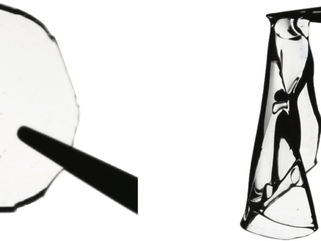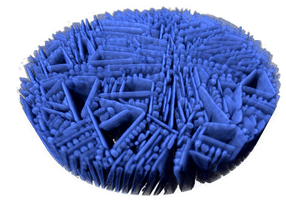Three Colors: Green
Electrically conducting green polymer completes the three primary colors- a step toward a plastic display?
Three colors are enough to produce any shade of color one could desire: the primary colors red, blue, and green. Red and blue electrochromic polythiophenes (electrically conducting polymers that change color depending on an applied voltage) were previously known. Only the third color, green, was missing. American researchers working with Fred Wudl have now filled this gap-an important step for the development of polymer-based optoelectronic components, such as plastic displays.
On a television screen or computer monitor, color pictures are made by tiny points (pixels) consisting of three individual areas that can be controlled individually and are equipped with color filters. In modern flat-panel displays, this control is achieved by applying a voltage to a cell filled with liquid crystals. The cell thus acts as a kind of switchable light "valve" that can either be transparent or opaque. These expensive cells of liquid crystals could be left out if it were only possible to directly switch the light filters themselves off and on. In principle, such a solution is feasible-with the use of colored, electrically conducting plastics that are also electrochromic. This means that the polymers change color when their redox state is changed by the application of an electrical voltage. For use in displays, the polymers should switch between one of the three primary colors and a transparent state.
Whereas red and blue electrochromic polymers are relatively easily accessible, it is difficult to develop the green variety. Why? The color arises because a portion of visible light in a specific wavelength range is absorbed by the electron system of the polymer molecules. The remaining light waves that do pass through the layer of plastic then combine to give the observed color. In order to produce red or blue, the polymer needs to have only one absorption band. For green, however, it must have bands in both the red and blue spectral regions. If the molecule is then converted from a neutral to an oxidized state by the application of a voltage, it is supposed to become transparent. Both absorption bands thus have to disappear in the same voltage range, which is nearly impossible. Wudl and his colleagues thus resorted to a trick: they constructed a polymer molecule whose backbone contains two independent color-producing electron systems, one for each of the two required absorption bands. The new polythiophene derivative is the first electrically conducting polymer that is green in its neutral state, and thus completes the polythiophene color trio.
Most read news
Organizations
Other news from the department science

Get the chemical industry in your inbox
From now on, don't miss a thing: Our newsletter for the chemical industry, analytics, lab technology and process engineering brings you up to date every Tuesday and Thursday. The latest industry news, product highlights and innovations - compact and easy to understand in your inbox. Researched by us so you don't have to.




























































